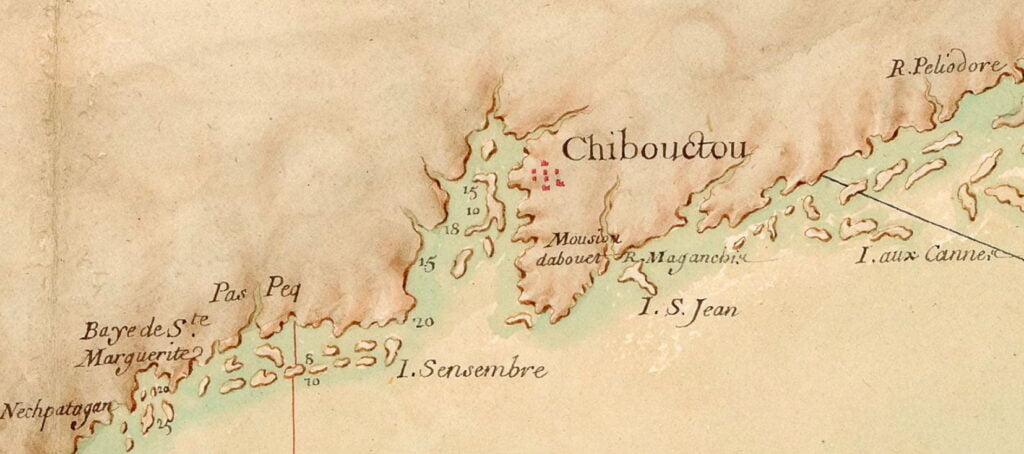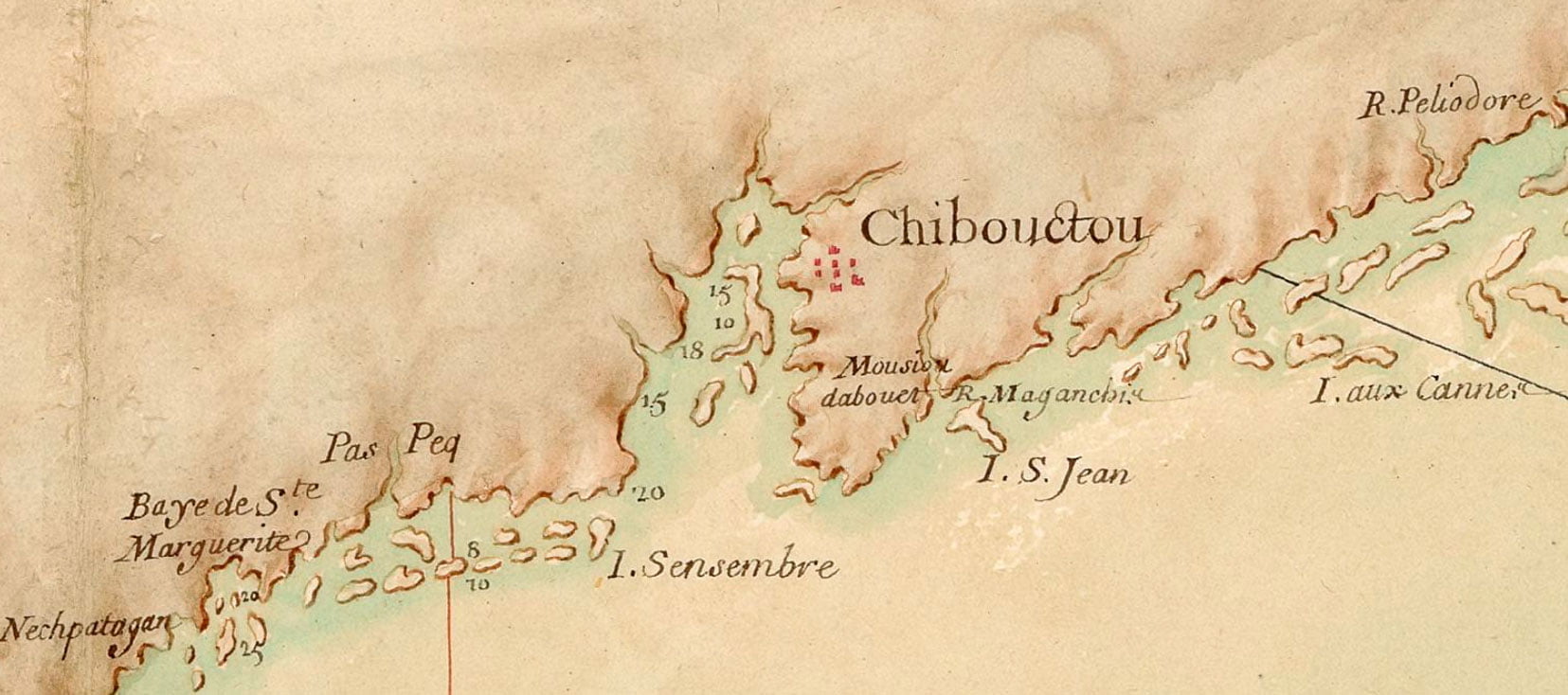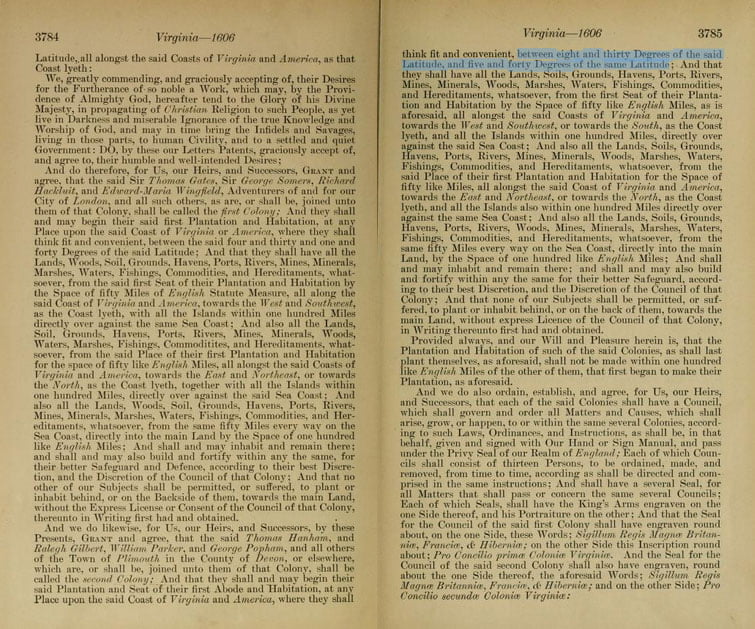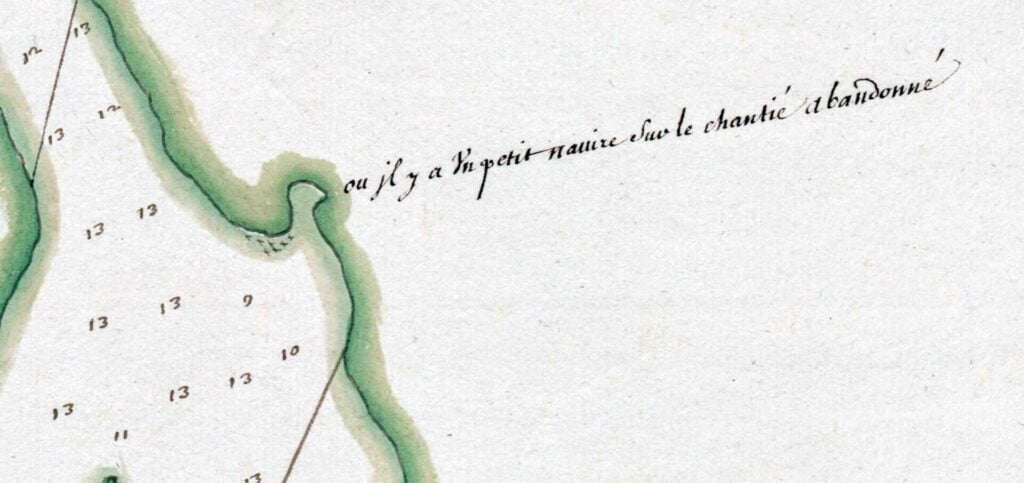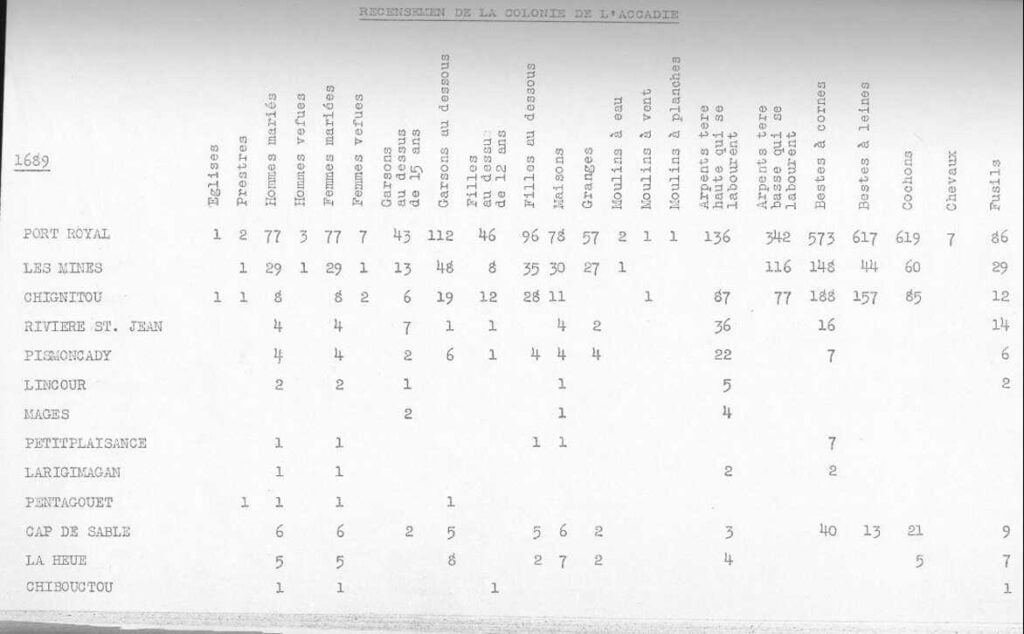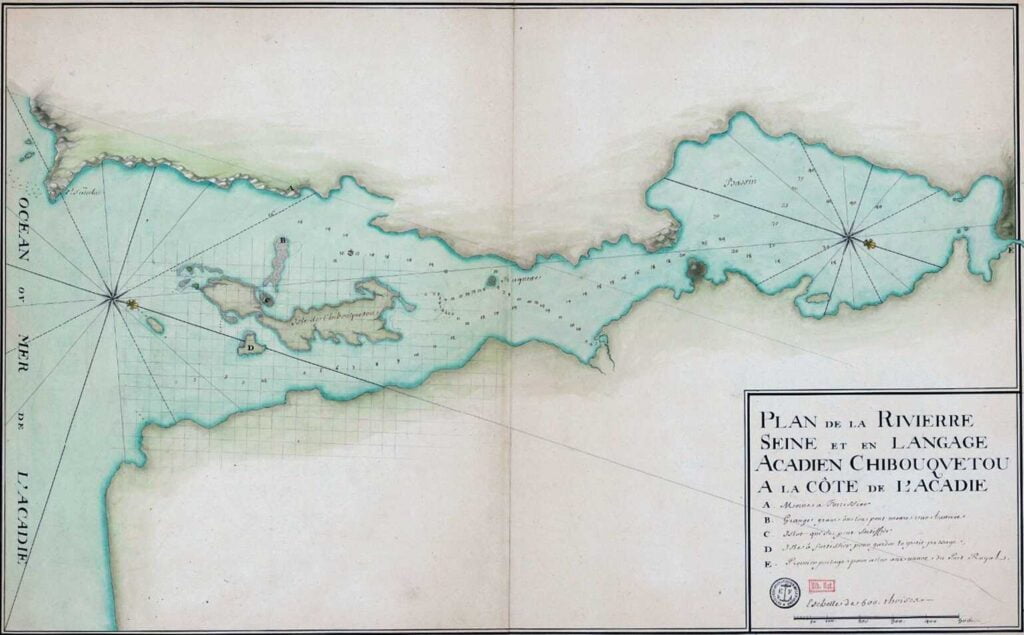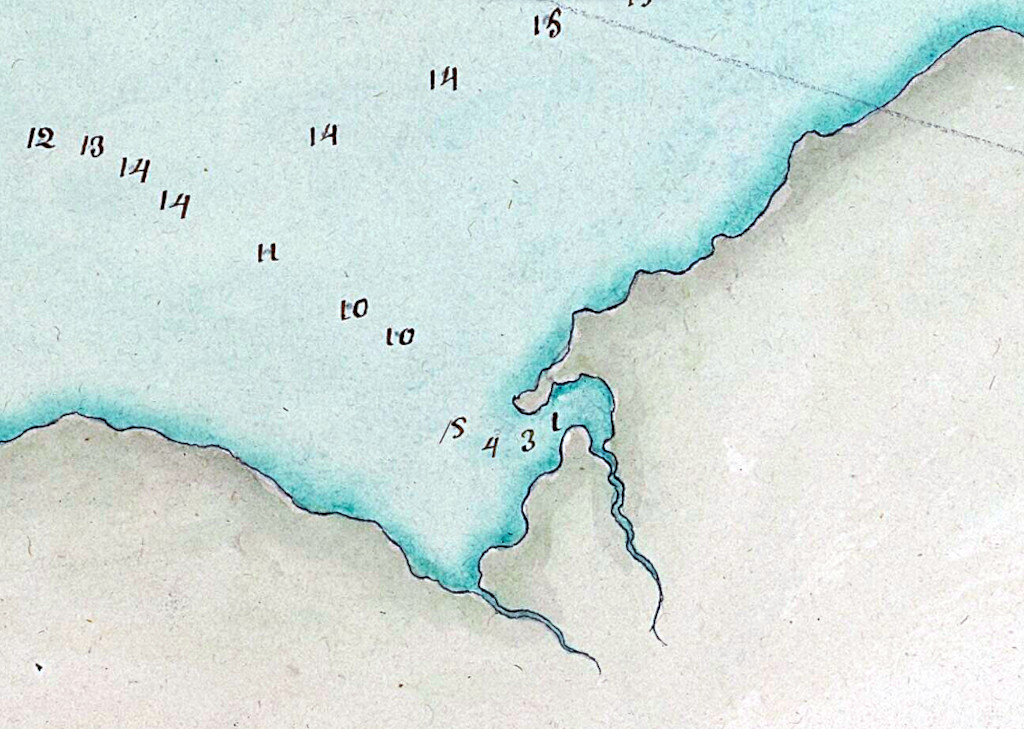Though not explicitly mentioned since it hadn’t yet been claimed or founded as such, parts of Nova Scotia are included in the first charter of Virginia, the second colony of which (otherwise known as the Popham Colony) was defined as “any place upon the said coast of Virginia and America…between 38°N and 45°N latitude…all alongst the said coast of Virginia and America…towards the East and Northeast, or towards the north, as the coast lyeth, and all the islands also within one hundred miles directly over against the same sea coast.”
I believe this is at least part of the source of Thomas Jefferson’s interest in the cessions of Nova Scotia in his Notes on the State of Virginia.
JAMES, by the Grace of God, King of England, Scotland, France and Ireland, Defender of the Faith, &c. WHEREAS our loving and well-disposed Subjects, Sir Thorn as Gales, and Sir George Somers, Knights, Richard Hackluit, Clerk, Prebendary of Westminster, and Edward-Maria Wingfield, Thomas Hanharm and Ralegh Gilbert, Esqrs. William Parker, and George Popham, Gentlemen, and divers others of our loving Subjects, have been humble Suitors unto us, that We would vouchsafe unto them our Licence, to make Habitation, Plantation, and to deduce a colony of sundry of our People into that part of America commonly called VIRGINIA, and other parts and Territories in America, either appertaining unto us, or which are not now actually possessed by any Christian Prince or People, situate, lying, and being all along the Sea Coasts, between four and thirty Degrees of Northerly Latitude from the Equinoctial Line, and five and forty Degrees of the same Latitude, and in the main Land between the same four and thirty and five and forty Degrees, and the Islands thereunto adjacent, or within one hundred Miles of the Coast thereof;
And to that End, and for the more speedy Accomplishment of their said intended Plantation and Habitation there, are desirous to divide themselves into two several Colonies and Companies; the one consisting of certain Knights, Gentlemen, Merchants, and other Adventurers, of our City of London and elsewhere, which are, and from time to time shall be, joined unto them, which do desire to begin their Plantation and Habitation in some fit and convenient Place, between four and thirty and one and forty Degrees of the said Latitude, alongst the Coasts of Virginia, and the Coasts of America aforesaid: And the other consisting of sundry Knights, Gentlemen, Merchants, and other Adventurers, of our Cities of Bristol and Exeter, and of our Town of Plimouth, and of other Places, which do join themselves unto that Colony, which do desire to begin their Plantation and Habitation in some fit and convenient Place, between eight and thirty Degrees and five and forty Degrees of the said Latitude, all alongst the said Coasts of Virginia and America, as that Coast lyeth:
We, greatly commending, and graciously accepting of, their Desires for the Furtherance of so noble a Work, which may, by the Providence of Almighty God, hereafter tend to the Glory of his Divine Majesty, in propagating of Christian Religion to such People, as yet live in Darkness and miserable Ignorance of the true Knowledge and Worship of God, and may in time bring the Infidels and Savages, living in those parts, to human Civility, and to a settled and quiet Government: DO, by these our Letters Patents, graciously accept of, and agree to, their humble and well-intended Desires;
And do therefore, for Us, our Heirs, and Successors, GRANT and agree, that the said Sir Thomas Gates, Sir George Somers, Richard Hackluit, and Edward-Maria Wingfield, Adventurers of and for our City of London, and all such others, as are, or shall be, joined unto them of that Colony, shall be called the first Colony; And they shall and may begin their said first Plantation and Habitation, at any Place upon the said-Coast of Virginia or America, where they shall think fit and convenient, between the said four and thirty and one and forty Degrees of the said Latitude; And that they shall have all the Lands, Woods, Soil, Grounds, Havens, Ports, Rivers, Mines, Minerals, Marshes, Waters, Fishings, Commodities, and Hereditaments, whatsoever, from the said first Seat of their Plantation and Habitation by the Space of fifty Miles of English Statute Measure, all along the said Coast of Virginia and America, towards the West and Southwest, as the Coast lyeth, with all the Islands within one hundred Miles directly over against the same Sea Coast; And also all the Lands, Soil, Grounds, Havens, Ports, Rivers, Mines, Minerals, Woods, Waters, Marshes, Fishings, Commoditites, and Hereditaments, whatsoever, from the said Place of their first Plantation and Habitation for the space of fifty like English Miles, all alongst the said Coasts of Virginia and America, towards the East and Northeast, or towards the North, as the Coast lyeth, together with all the Islands within one hundred Miles, directly over against the said Sea Coast, And also all the Lands, Woods, Soil, Grounds, Havens, Ports, Rivers, Mines, Minerals, Marshes, Waters, Fishings, Commodities, and Hereditaments, whatsoever, from the same fifty Miles every way on the Sea Coast, directly into the main Land by the Space of one hundred like English Miles; And shall and may inhabit and remain there; and shall and may also build and fortify within any the same, for their better Safeguard and Defense, according to their best Discretion, and the Discretion of the Council of that Colony; And that no other of our Subjects shall be permitted, or suffered, to plant or inhabit behind, or on the Backside of them, towards the main Land, without the Express License or Consent of the Council of that Colony, thereunto in Writing; first had and obtained.
And we do likewise, for Us, Our Heirs, and Successors, by these Presents, GRANT and agree, that the said Thomas Hanham, and Ralegh Gilbert, William Parker, and George Popham, and all others of the Town of Plimouth in the County of Devon, or elsewhere which are, or shall be, joined unto them of that Colony, shall be called the second Colony; And that they shall and may begin their said Plantation and Seat of their first Abode and Habitation, at any Place upon the said Coast of Virginia and America, where they shall think fit and convenient, between eight and thirty Degrees of the said Latitude, and five and forty Degrees of the same Latitude; And that they shall have all the Lands, Soils, Grounds, Havens, Ports, Rivers, Mines, Minerals, Woods, Marshes, Waters, Fishings, Commodities, and Hereditaments, whatsoever, from the first Seat of their Plantation and Habitation by the Space of fifty like English Miles, as is aforesaid, all alongst the said Coasts of Virginia and al raerica towards the West and Southwest, or towards the South, as the Coast lyeth, and all the Islands within one hundred Miles, directly over against the said Sea Coast; And also all the Lands, Soils, Grounds, Havens, Ports, Rivers, Mines, Minerals, Woods, Marshes, Waters, Fishings, Commodities, and Hereditaments, whatsoever, from the said Place of their first Plantation and Habitation for the Space of fifty like Miles, all alongst the said Coast of Virginia and America, towards the least and Northeast, or towards the North, as the Coast lyeth, and all the Islands also within one hundred Miles directly over against the same Sea Coast; And also all the Lands, Soils, Grounds, Havens, Ports, Rivers, Woods, Mines, Minerals, Marshes, Waters, Fishings, Commodities, and Hereditaments, whatsoever, from the same fifty Miles every way on the Sea Coast, directly into the main Land, by the Space of one hundred like English Miles; And shall and may inhabit and remain there; and shall and may also build and fortify within any the same for their better Safeguard, according to their best Discretion, and the Discretion of the Council of that Colony; And that none of our Subjects shall be permitted, or suffered, to plant or inhabit behind, or on the back of them, towards the main Land, without express Licence of the Council of that Colony, in Writing thereunto first had and obtained.
Provided always, and our Will and Pleasure herein is, that the Plantation and Habitation of such of the said Colonies, as shall last plant themselves, as aforesaid, shall not be made within one;hundred like English Miles of the other of them, that first began to make their Plantation, as aforesaid.
And we do also ordain, establish, and agree, for Us, our Heirs, and Successors, that each of the said Colonies shall have a Council, which shall govern and order all Matters-and Causes, which shall arise, grow, or happen, to or within the same several Colonies, according to such Laws, Ordinances, and Instructions, as shall be, in that behalf, given and signed with Our Hand or Sign Manual, and pass under the Privy Seal of our Realm of England; Each of which Councils shall consist of thirteen Persons, to be ordained, made, and removed, from time to time, according as shall be directed and comprised in the same instructions; And shall have a several Seal, for all Matters that shall pass or concern the same several Councils; Each of which Seals, shall have the King’s Arms engraver on the one Side thereof, and his Portraiture on the other; And that the Seal for the Council of the said first Colony shall have engraver round about, on the one Side, these Words; Sigillum Regis Magne Britanniae, Franciae, & Hiberniae; on the other Side this Inscription round about; Pro Concilio primae Coloniae Virginiae. And the Seal for the Council of the said second Colony shall also have engraven, round about the one Side thereof, the aforesaid Words; Sigillum Regis Magne Britanniae, Franciae, & Hiberniae; and on the other Side; Pro Concilio primae Coloniae Virginiae:
And that also there shall be a Council, established here in England, which shall, in like manner, consist of thirteen Persons, to be for that Purpose, appointed by Us, our Heirs and Successors, which shall be called our Council of Virginia; And shall, from time to time, have the superior Managing and Direction, only of and for all Matters that shall or may concern the Government, as well of the said several Colonies, as of and for any other Part or Place, within the aforesaid Precincts of four and thirty and five and forty Degrees abovementioned; Which Council shall, in like manner, have a Seal, for matters concerning the Council or Colonies, with the like Arms and Portraiture, as aforesaid, with this inscription, engraver round about on the one Side; Sigillum Regis Magne Britanniae, Franciae, & Hiberniae; and round about on the other Side, Pro Concilio fuo Virginiae.
And moreover, we do GRANT and agree, for Us, our Heirs and Successors; that that the said several Councils of and for the said several Colonies, shall and lawfully may, by Virtue hereof, from time to time, without any Interruption of Us, our Heirs or Successors, give and take Order, to dig, mine, and search for all Manner of Mines of Gold, Silver, and Copper, as well within any Part of their said several Colonies, as of the said main Lands on the Backside of the same Colonies; And to HAVE and enjoy the Gold, Silver, and Copper, to be gotten thereof, to the Use and Behoof of the same Colonies, and the Plantations thereof; YIELDING therefore to Us, our Heirs and Successors, the fifth Part only of all the same Gold and Silver, and the fifteenth Part of all the same Copper, so to be gotten or had, as is aforesaid, without any other Manner of Profit or Account, to be given or yielded to Us, our Heirs, or Successors, for or in Respect of the same:
And that they shall, or lawfully may, establish and cause to be made a Coin, to pass current there between the people of those several Colonies, for the more Ease of Traffick and Bargaining between and amongst them and the Natives there, of such Metal, and in such Manner and Form, as the said several Councils there shall limit and appoint.
And we do likewise, for Us, our Heirs, and Successors, by these Presents, give full Power and Authority to the said Sir Thomas Gates, Sir George Somers, Richard Hackluit, Edward-Maria Wingfeld, Thomas Hanham, Ralegh Gilbert, William Parker, and George Popham, and to every of them, and to the said several Companies, Plantations, and Colonies, that they, and every of them, shall and may, at all and every time and times hereafter, have, take, and lead in the said Voyage, and for and towards the said several Plantations, and Colonies, and to travel thitherward, and to abide and inhabit there, in every the said Colonies and Plantations, such and so many of our Subjects, as shall willingly accompany them or any of them, in the said Voyages and Plantations; With sufficient Shipping, and Furniture of Armour, Weapons, Ordinance, Powder, Victual, and all other things, necessary for the said Plantations, and for their Use and Defence there: PROVIDED always, that none of the said Persons be such, as shall hereafter be specially restrained by Us, our Heirs, or Successors.
Moreover, we do, by these Presents, for Us, our Heirs, and Successors, GIVE AND GRANT Licence unto the said Sir Thomas Gates, Sir George Somers, Richard Hackluit, Edward-Maria Wingfield, Thornas Hanham, Ralegh Gilbert, William Parker, and George Popham, and to every of the said Colonies, that they, and every of them, shall and may, from time to time, and at all times forever hereafter, for their several Defences, encounter, expulse, repel, and resist, as well by Sea as by Land, by all Ways and Means whatsoever, all and every such Person or Persons, as without the especial Licence of the said several Colonies and Plantations, shall attempt to inhabit within the said several Precincts and Limits of the said several Colonies and Plantations, or any of them, or that shall enterprise or attempt, at any time hereafter, the Hurt, Detriment, or Annoyance, of the said several Colonies or Plantations:
Giving and granting, by these Presents, unto the said Sir Thomas Gates, Sir George Somers, Richard Hackluit, Edward-Maria Wingfield, Thornas Hanham, Ralegh Gilbert, William Parker, and George Popham, and their Associates of the said second Colony, arid to every of them, from time to time, and at all times for ever hereafter, Power and Authority to take and surprise, by all Ways and Means whatsoever, all and every Person and Persons, with their Ships, Vessels, Goods, and other Furniture, which shall be found trafficking, into any Harbour or Harbours, Creek or Creeks, or Place, within the Limits ok Precincts of the said several Colonies and Plantations, not being of the same Colony, until such time, as they, being of any Realms, or Dominions under our Obedience, shall pay, or agree to pay, to the Hands of the Treasurer of that Colony, within whose Limits and Precincts they shall so traffick, two and a half upon every Hundred, of any thing so by them trafficked, bought, or sold; And being Strangers, and not Subjects under our Obeysance, until they shall pay five upon every Hundred, of such Wares and Merchandises, as they shall traffick, buy, or sell, within the Precincts of the said several Colonies, wherein they shall so traffick, buy, or sell, as aforesaid; WHICH Sums of Money, or Benefit, as aforesaid, for and during the Space of one and twenty Years, next ensuing the Date hereof, shall be wholly emploied to the Use, Benefit, and Behoof of the said several Plantations, where such Traffick shall be made; And after the said one and twenty Years ended, the same shall be taken to the Use of Us, our Heires, and Successors, by such Officers and Ministers as by Us, our Heirs, and Successors, shall be thereunto assigned or appointed.
And we do further, by these Presents, for Us, our Heirs and Successors, GIVE AND GRANT unto the said Sir Thomas Gates, Sir George Sommers, Richard Hackluit, and Edward-Maria Wingfield, and to their Associates of the said first Colony and Plantation, and to the said Thomas Hanham, Ralegh Gilbert, William Parker, and George Popham, and their Associates of the said second Colony and Plantation, that they, and every of them, by their Deputies, Ministers, and Factors, may transport the Goods, Chattels, Armour, Munition, and Furniture, needful to be used by them, for their said Apparel, Food, Defence, or otherwise in Respect of the said Plantations, out of our Realms of England and Ireland, and all other our Dominions, from time to time, for and during the Time of seven Years, next ensuing the Date hereof, for the better Relief of the said several Colonies and Plantations, without any Customs, Subsidy, or other Duty, unto Us, our Heirs, or Successors, to be yielded or payed for the same.
Also we do, for Us, our Heirs, and Successors, DECLARE, by these Presents, that all and every the Persons being our Subjects, which shall dwell and inhabit within every or any of the said several Colonies and Plantations, and every of their children, which shall happen to be born within any of the Limits and Precincts of the said several Colonies and Plantations, shall HAVE and enjoy all Liberties, Franchises, and Immunities, within any of our other Dominions, to all Intents and Purposes, as if they had been abiding and born, within this our Realm of England, or any other of our said Dominions.
Moreover, our gracious Will and Pleasure is, and we do, by these Presents, for Us, our Heirs, and Successors, declare and set forth, that if any Person or Persons, which shall be of any of the said Colonies and Plantations, or any other, which shall trick to the said Colonies and Plantations, or any of them, shall, at any time or times hereafter, transport any Wares, Merchandises, or Commodities, out of any of our Dominions, with a Pretence to land, sell, or otherwise dispose of the same, within any the Limits and Precincts of any of the said Colonies and Plantations, and yet nevertheless, being at Sea, or after he hath landed the same within any of the said Colonies and Plantations, shall carry the same into any other Foreign Country, with a Purpose there to sell or dispose of the same, without the Licence of Us, our Heirs, and Successors, in that Behalf first had and obtained; That then, all the Goods and Chattels of such Person or Persons, so offending and transporting together with the said Ship or Vessel, wherein such Transportation was made, shall be forfeited to Us, our Heirs, and Successors.
Provided always, and our Will and Pleasure is, and we do hereby declare to all Christian Kings, Princes, and States, that if any Person or Persons which shall hereafter be of any of the said several Colonies and Plantations, or any other, by his, their, or any of their Licence and Appointment, shall, at any Time or Times hereafter, rob or spoil, by Sea or Land, or do any Act of unjust and unlawful Hostility to any the Subjects of Us, our Heirs, or Successors, or any the Subjects of any King, Prince, Ruler, Governor, or State, being then in League or Amitie with Us, our Heirs, or Successors, and that upon such Injury, or upon just Complaint of such Prince, Ruler, Governor, or State, or their Subjects, We, our Heirs, or Successors, shall make open Proclamation, within any of the Ports of our Realm of England, commodious for that purpose, That the said Person or Persons, having committed any such robbery, or Spoil, shall, within the term to be limited by such Proclamations, make full Restitution or Satisfaction of all such Injuries done, so as the said Princes, or others so complaining, may hold themselves fully satisfied and contented; And, that if the said Person or Persons, having committed such Robery or Spoil, shall not make, or cause to be made Satisfaction accordingly, within such Time so to be limited, That then it shall be lawful to Us, our Heirs, and Successors, to put the said Person or Persons, having committed such Robbery or Spoil, and their Procurers, Abettors, and Comforters, out of our Allegiance and Protection; And that it shall be lawful and free, for all Princes, and others to pursue with hostility the said offenders, and every of them, and their and every of their Procurers, Aiders, abettors, and comforters, in that behalf.
And finally, we do for Us, our Heirs, and Successors, and agree, to and with the said Sir Thomas Gates, Sir George Somers, Richard Hackluit, Edward-Maria Wingfield, and all others of the said first colony, that We, our Heirs and Successors, upon Petition in that Behalf to be made, shall, by Letters Patent under the Great Seal of England, GIVE and GRANT unto such Persons, their Heirs and Assigns, as the Council of that Colony, or the most part of then, shall, for that Purpose, nominate and assign all the lands, Tenements, and Hereditaments, which shall be within the Precincts limited for that Colony, as is aforesaid, To BE HOLDEN of Us, our heirs and Successors, as of our Manor at East-Greenwich, in the County of Kent, in free and common Soccage only, and not in Capite:
And do in like Manner, Grant and Agree, for Us, our Heirs and Successors, to and with the said Thomas Hanham, Ralegh Gilbert, William Parker, and George Popham, and all others of the said second Colony, That We, our Heirs, and Successors, upon Petition in that Behalf to be made, shall, by Letters-Patent, under the Great Seal of England, GIVE and GRANT, unto such Persons, their Heirs and Assigns, as the Council of that Colony, or the most Part of them, shall for that Purpose nominate and assign, all the Lands, Tenements, and Hereditaments, which shall be within the Precincts limited for that Colony, as is aforesaid, To BE nodded of Us, our Heires, and Successors, as of our Manor of East-Greenwich, in the County of Kent, in free and common Soccage only, and not in Capite.
All which Lands, Tenements, and Hereditaments, so to be passed by the said several Letters-Patent, shall be sufficient Assurance from the said Patentees, so distributed and divided amongst the Undertakers for the Plantation of the said several Colonies, and such as shall make their Plantations in either of the said several Colonies, in such Manner and Form, and for such Estates, as shall be ordered and set down by the Council of the said Colony, or the most part of them, respectively, within which the same Lands, Tenements, and Hereditaments shall lye or be; Although express Mention of the true yearly Value or Certainty of the Premises, or any of them, or of any other Gifts or Grants, by Us or any of our Progenitors or Predecessors, to the aforesaid Sir Thomas Gates, Knt. Sir George Somers, Knt. Richard Hackluit, Edward-Maria Wingfield, Thomas Hanham, Ralegh Gilbert, William Parker, and George Popham, or any of them, heretofore made, in these Presents, is not made; Or any Statute, Act, Ordinance, or Provision, Proclamation, or Restraint, to the contrary hereof had, made, ordained, or any other Thing, Cause, or Matter whatsoever, in any wise notwithstanding. IN Witness whereof, we have caused these our Letters to be made Patent; Witness Ourself at Westminster, the tenth Day of April, in the fourth Year of our Reign of England, France, and Ireland, and of Scotland the nine and thirtieth.
LUKIN
Per breve de private Sigillo.
Thorpe, Francis Newton. “The Federal and State constitutions: colonial charters, and other organic laws of the States, territories, and Colonies, now or heretofore forming the United States of America” Washington : Govt. Print. Off. 1909. https://archive.org/details/federalstatecons07thor/page/n5/mode/2up
